The world watched on television as Neil Armstrong took the first steps on the moon’s surface on July 20, 1969. It was the first time humans walked another world. As he stepped onto the lunar surface, Armstrong said, “That is one small step for [a] man, one giant leap for mankind.”
July 20, 1969. On this date, Apollo 11 astronauts Buzz Aldrin and Neil Armstrong landed their moon module on a broad dark lunar lava flow, called the Sea of Tranquility. Six hours later, Neil Armstrong became the first human being to walk on the surface of a world beyond Earth.
Armstrong and Aldrin spent 21 1/2 hours on the moon’s surface. They collected 47.5 pounds (21.5 kg) of moon rocks for return to Earth. Then they blasted off in their module from the lunar surface to meet up with Michael Collins in the command module orbiting overhead.
They returned safely to Earth and landed in the Pacific Ocean on July 24, 1969.
Apollo 11 launch at 13:32:00 UTC (9:32:00 a.m. EDT local time) on July 16, 1969. Astronauts Neil A. Armstrong, Michael Collins and Edwin E. Aldrin, Jr., were aboard.

Apollo 11 left Earth via a type of rocket now no longer used, called a Saturn V. The giant Saturn V rocket was 111 meters (363 feet) tall, about the height of a 36-story-tall building. Read more about the Saturn V rocket.
The Apollo command module’s position atop the Saturn V, at launch. The lunar module – the craft that descended to the moon’s surface – is positioned just below the command module in this diagram.
Apollo 11 orbited Earth 1 1/2 times. Twelve minutes after launch, it separated from the Saturn V, as a propulsion maneuver sent it on a path toward the moon. Here is a view of Earth from Apollo 11, shortly after it left Earth orbit.
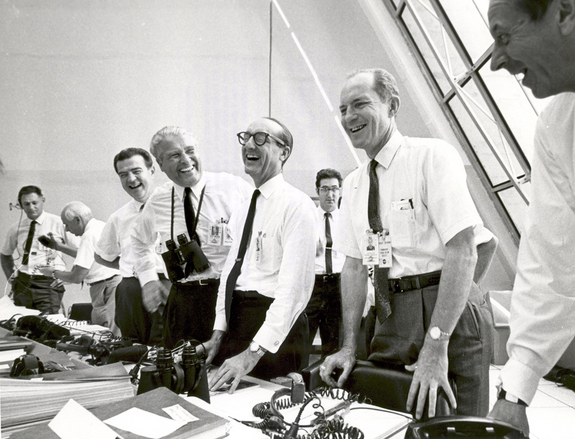
Happy Apollo 11 mission officials in the Launch Control Center following the successful Apollo 11 liftoff on July 16, 1969. The famous German rocket engineer Wernher von Braun is second from left (with binoculars). Read more about Wernher von Braun.
Buzz Aldrin looks into a TV camera during the third broadcast from space on the way to the moon.
Earth seen by Apollo 11 astronauts on their way to the moon.
Here is the Apollo 11 lunar module – the vehicle that would carry Neil Armstrong and Buzz Aldrin to the moon’s surface. It was called “Eagle.” This photo shows the module in a landing configuration, photographed in lunar orbit from the command module, which was called “Columbia.” Astronaut Michael Collins, alone aboard Columbia, inspected Eagle as it pirouetted before him to ensure the craft was not damaged.
The Eagle lunar module captured this image of the Columbia command module in lunar orbit. Columbia stayed in lunar orbit with Michael Collins aboard during Eagle’s descent and landing.
In the video below, you can hear the excitement in Armstrong’s voice at the successful landing of Eagle on the moon’s surface as he says:
Tranquility Base here. The Eagle has landed.
An early concern of space engineers had been that the lunar regolith, the fine soil covering the moon, would be soft like quicksand. There was some fear that the Eagle lunar module would sink after landing. Hence Armstrong’s comment about the depth of the footpads in the lunar soil as he descended the ladder before stepping onto the moon.
Buzz Aldrin descends the steps of the lunar module ladder as he becomes the second human being to walk on the moon.
Armstrong and Aldrin at work on the moon. They deployed a U.S. flag and several science experiments, and collected moon rocks.
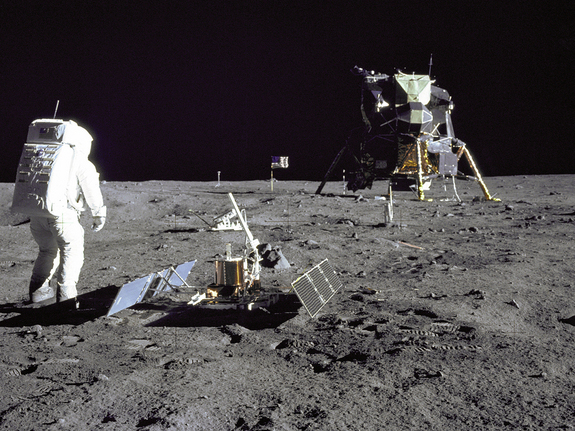
Here is Buzz Aldrin, who piloted the lunar module Eagle to the moon’s surface, with the LR-3, a reflecting array designed to bounce laser beams fired from Earth back to Earth. This experiment, which helped refine our knowledge of the moon’s distance and the shape of its orbit around Earth, is still returning data from the moon.
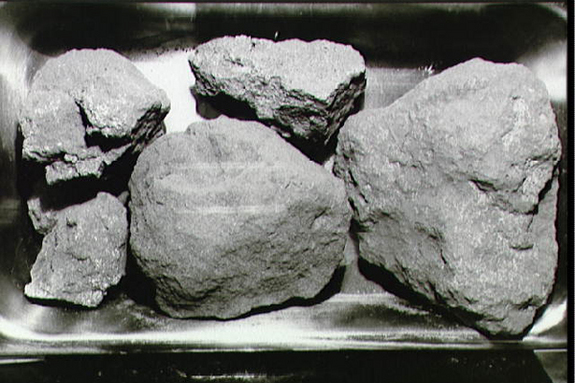
The Apollo astronauts brought the first moon rocks back to Earth. Here is sample number 10046.
The lunar module Eagle on the surface of the moon.

Neil Armstrong in the lunar module Eagle shortly after his historic first moonwalk, when he became the first human to set foot on a world besides Earth.
Michael Collins caught this photo of the lunar module with Armstrong and Aldrin inside – and with Earth in the distance – as the module ascended from the moon’s surface to rejoin the command module. The lunar module docked with the orbiting command module, and, shortly afterwards, the astronauts began their journey back to Earth.
There were no runway landings in those days. Splashdown for the three astronauts was in the Pacific Ocean. Here, they await pickup by a helicopter from the USS Hornet.
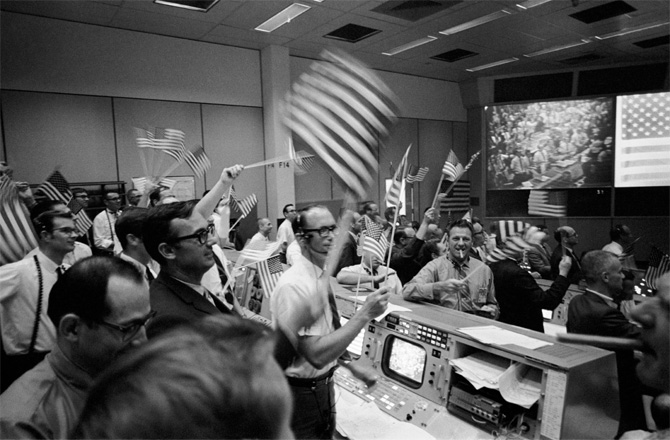
Celebration at Mission Control as Apollo 11 draws to a successful end.
Ticker-tape parade for the Apollo 11 astronauts in New York City on August 13, 1969. This section of Broadway is known as the Canyon of Heroes.
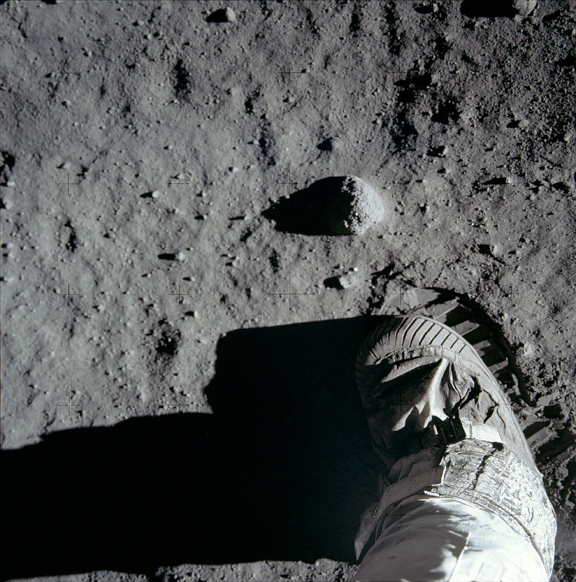
Human footprint on the moon.
Experience the Apoll 11 landing site as it appears today, in this video:
Bottom line: Today is the anniversary of the 1969 Apollo 11 moon landing, the first manned expedition to another world.
Experience the Apollo 11 landing in video and actual sound at this cool site.
Don’t believe it? Try this video: Why the Apollo moon landings could not have been faked.
A complete Apollo 11 timeline from NASA
from EarthSky https://ift.tt/131Ub4d
The world watched on television as Neil Armstrong took the first steps on the moon’s surface on July 20, 1969. It was the first time humans walked another world. As he stepped onto the lunar surface, Armstrong said, “That is one small step for [a] man, one giant leap for mankind.”
July 20, 1969. On this date, Apollo 11 astronauts Buzz Aldrin and Neil Armstrong landed their moon module on a broad dark lunar lava flow, called the Sea of Tranquility. Six hours later, Neil Armstrong became the first human being to walk on the surface of a world beyond Earth.
Armstrong and Aldrin spent 21 1/2 hours on the moon’s surface. They collected 47.5 pounds (21.5 kg) of moon rocks for return to Earth. Then they blasted off in their module from the lunar surface to meet up with Michael Collins in the command module orbiting overhead.
They returned safely to Earth and landed in the Pacific Ocean on July 24, 1969.
Apollo 11 launch at 13:32:00 UTC (9:32:00 a.m. EDT local time) on July 16, 1969. Astronauts Neil A. Armstrong, Michael Collins and Edwin E. Aldrin, Jr., were aboard.

Apollo 11 left Earth via a type of rocket now no longer used, called a Saturn V. The giant Saturn V rocket was 111 meters (363 feet) tall, about the height of a 36-story-tall building. Read more about the Saturn V rocket.
The Apollo command module’s position atop the Saturn V, at launch. The lunar module – the craft that descended to the moon’s surface – is positioned just below the command module in this diagram.
Apollo 11 orbited Earth 1 1/2 times. Twelve minutes after launch, it separated from the Saturn V, as a propulsion maneuver sent it on a path toward the moon. Here is a view of Earth from Apollo 11, shortly after it left Earth orbit.

Happy Apollo 11 mission officials in the Launch Control Center following the successful Apollo 11 liftoff on July 16, 1969. The famous German rocket engineer Wernher von Braun is second from left (with binoculars). Read more about Wernher von Braun.
Buzz Aldrin looks into a TV camera during the third broadcast from space on the way to the moon.
Earth seen by Apollo 11 astronauts on their way to the moon.
Here is the Apollo 11 lunar module – the vehicle that would carry Neil Armstrong and Buzz Aldrin to the moon’s surface. It was called “Eagle.” This photo shows the module in a landing configuration, photographed in lunar orbit from the command module, which was called “Columbia.” Astronaut Michael Collins, alone aboard Columbia, inspected Eagle as it pirouetted before him to ensure the craft was not damaged.
The Eagle lunar module captured this image of the Columbia command module in lunar orbit. Columbia stayed in lunar orbit with Michael Collins aboard during Eagle’s descent and landing.
In the video below, you can hear the excitement in Armstrong’s voice at the successful landing of Eagle on the moon’s surface as he says:
Tranquility Base here. The Eagle has landed.
An early concern of space engineers had been that the lunar regolith, the fine soil covering the moon, would be soft like quicksand. There was some fear that the Eagle lunar module would sink after landing. Hence Armstrong’s comment about the depth of the footpads in the lunar soil as he descended the ladder before stepping onto the moon.
Buzz Aldrin descends the steps of the lunar module ladder as he becomes the second human being to walk on the moon.
Armstrong and Aldrin at work on the moon. They deployed a U.S. flag and several science experiments, and collected moon rocks.

Here is Buzz Aldrin, who piloted the lunar module Eagle to the moon’s surface, with the LR-3, a reflecting array designed to bounce laser beams fired from Earth back to Earth. This experiment, which helped refine our knowledge of the moon’s distance and the shape of its orbit around Earth, is still returning data from the moon.

The Apollo astronauts brought the first moon rocks back to Earth. Here is sample number 10046.
The lunar module Eagle on the surface of the moon.

Neil Armstrong in the lunar module Eagle shortly after his historic first moonwalk, when he became the first human to set foot on a world besides Earth.
Michael Collins caught this photo of the lunar module with Armstrong and Aldrin inside – and with Earth in the distance – as the module ascended from the moon’s surface to rejoin the command module. The lunar module docked with the orbiting command module, and, shortly afterwards, the astronauts began their journey back to Earth.
There were no runway landings in those days. Splashdown for the three astronauts was in the Pacific Ocean. Here, they await pickup by a helicopter from the USS Hornet.

Celebration at Mission Control as Apollo 11 draws to a successful end.
Ticker-tape parade for the Apollo 11 astronauts in New York City on August 13, 1969. This section of Broadway is known as the Canyon of Heroes.

Human footprint on the moon.
Experience the Apoll 11 landing site as it appears today, in this video:
Bottom line: Today is the anniversary of the 1969 Apollo 11 moon landing, the first manned expedition to another world.
Experience the Apollo 11 landing in video and actual sound at this cool site.
Don’t believe it? Try this video: Why the Apollo moon landings could not have been faked.
A complete Apollo 11 timeline from NASA
from EarthSky https://ift.tt/131Ub4d

Aucun commentaire:
Enregistrer un commentaire